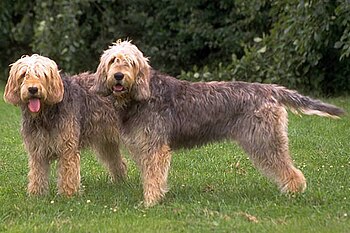 |
| Otterhound (Photo credit: Wikipedia) |
History. The Otterhound, as you may guess, was first bred for controlling the otter population, on English rivers. The otters became a problem by eating, and therefore diminishing the supply of, fish. The Otterhounds were led along the riverbanks and encouraged to chase and kill the pesky predators. The breed, as it is known today, was first brought about in 18th century England, although its ancestors have been traced back as far as the 12th century. The breed was first introduced to America in the 20th century, with the first dog appearing at a kennel club show in Oklahoma in 1907. This is now a rare breed with a figure of fewer than 1,000 dogs remaining worldwide.
Temperament. The Otterhound is a boisterous and devoted dog which makes him an ideal family pet, also being of a fearless nature it's devotion makes it an ideal family pet, for families with children. Although they are bred for hunting the Otterhound is a sociable dog and gets on well with other animals, which means it should integrate into a household which has other pets. The Otterhound is a determined and intelligent dog, which makes it very important during training to establish that you are in command. If the Otterhound senses that the owners are not in total command then the dog may feel that it is the leader and thereby make any training very difficult. Otterhounds are also strong swimmers, and they swim for extended periods of time without resting. Due to its strength and stamina, the Otterhound does require a reasonable amount of exercise and playtime to ensure the dog does not become bored.
Health issues. Health issues that affect the Otterhound are very few, as they are a generally healthy breed. They do, however, sufferer the common problems of large pedigree dogs, which are hip dysplasia and bloat. There is a possibility of a genetic disorder which can lead to potentially fatal blood loss.
It is important to choose a reputable breeder when purchasing Otterhound, as they should be DNA tested to check that they are not susceptible to this genetic illness.
Grooming. A general brush through about twice a week with, a proper grooming about every 5 to 8 weeks. For their main grooming, you'll need to use a grooming rake to remove shed hair, although the Otterhound does not shed greatly it is quite important to get rid of any debris during grooming. It is important, as with most dogs, to keep the area under their tale well groomed, around their bottom; this reduces unpleasant matting during their toileting. Cut any straggly hair between the pads of their paws with scissors, generally tidy up their coat with thinning scissors, and cut any straggly hairs with scissors. You are now ready to bath your dog.
Living conditions. Otterhounds can be housed indoors or outside, in cool or warm regions. However, in cold climates, they need to be live indoors. They enjoy the freedom to roam and particularly enjoy sniffing around. When housed indoors consideration should be given to the space provided for them, as they do have a tendency to snore.
|

